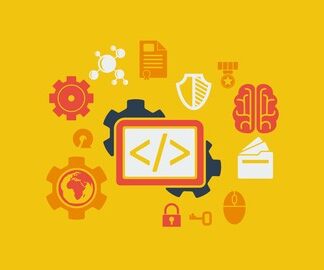
Let’s cover the things that you are actually going to learn in this course. It’s going to be very hands-on. So, I will not provide finalized files as much as possible because I need
you to write the code yourself, and that is the best way to learn. Simply copying will not produce good code. Now, the first thing we’re going to learn about is basic C# code, and this is the language used in Xamarin. C# is a language invented by Microsoft to go along with the .NET framework, and it’s a very elegant language, and in my opinion it is one of the better languages you can start by learning. It’s very modern and it takes all of the best parts of the other languages and puts them together in one place. In Xamarin, you can use another
language called F# and I believe you can use Visual Basic, but don’t quote me on that. I wouldn’t go down that route if I were you, I would stick with C# because most of the examples on the internet are in that language. Secondly, I assume, you know absolutely nothing about programming. So, I will leave nothing out. At times, this may seem laborious, and if you already know about programming you might roll your eyes and think, “Dude, I already know that.” But, it is more important to include everything at the risk of boredom rather than not include it, because at the end of this course I don’t want to leave you with lingering questions about why things are and how they work. Then we’re going to learn the basic structure of an iOS App. Since all Apple apps tend to follow a specific design pattern, and it’s very much the same with android apps, they follow a specific pattern. So if you think about both platforms, if you have ever scrolled through a list of things, both of the platforms implement a list. In iOS it is called a Table View and in Android it’s called a List View, and these are just a list of things and you can define whatever that thing is, but each operating system in both Apple and Android take care of all the heavy lifting for you in the background. Next, we’re gonna look at how to write as much shared code as possible for our apps. So, if we come back up here, I should put in one more thing, and this is going to be a database layer and then a data access layer. And then, we go down to the basic structure of iOS and Android apps. And now, these two sections are shared code and these two sections can be used by both iOS and android without modifying them at all, and that is fantastic because you will save about a third of your time because you’ve already written the base logic code for each app. And it doesn’t end there, because Xamarin will allow you to write Windows phone apps, and it will allow you to write Windows Desktop applications, as well as Mac applications. So, it’s absolutely great for that. Right, second to last, I’m going to show you how to use SQlite databases on your devices. Now, most mobile devices come with this as a standard. To access SQlite databases, if you know about anything about databases, you’ll know we need to know a database query language. But, for this course we don’t need to go into that because we’re going to use a very popular library called SQlite.net which is free on most platforms, in fact all platforms, I think. This concept of a database you’re going to use time and time again with any apps you create. Absolutely any app you create! If you want to save data, this is how you’ll do it. Finally, we’re going to look at some of the common pitfalls in mobile app development. The primary of which, will be things like memory leaks. So, if I have say an image, this image requires memory. If I load another image, then that’s going to add some more memory in use. As you know, mobile devices don’t have a lot of memory, so you can reach a point where memory will be full. At those points your app will usually crash, and the app doesn’t work anymore. So, I’m going to give you a few pointers in both platforms on how to avoid this common pitfall. So, join me in lecture 3 when we’ll begin setting up our Mac or PC.










There is certainly a great deal to find out about this subject. I really like all the points you have made.|